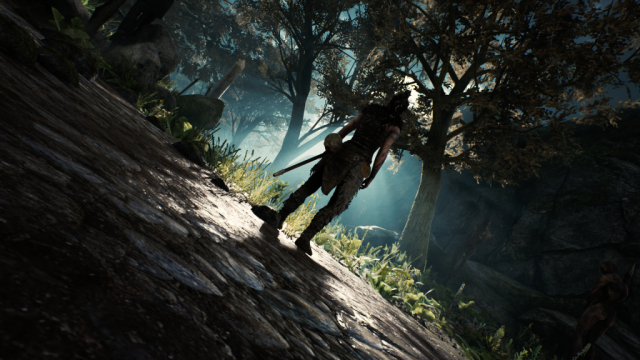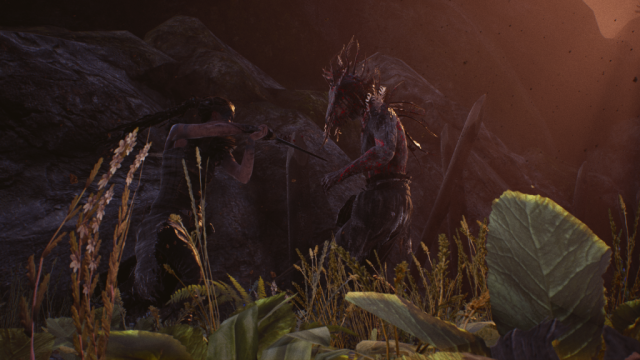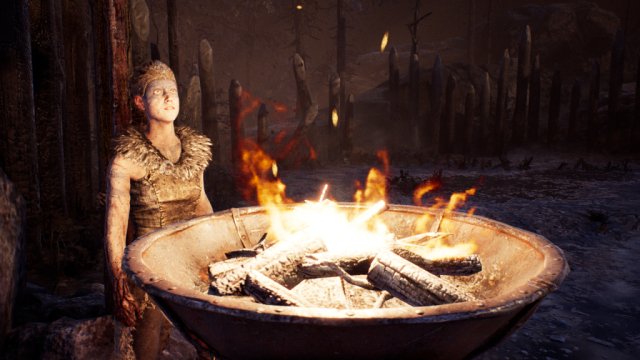When it comes to the topic of psychosis and mental illness in video games, it is usually used as a justification for a villain’s world-destroying plans or used as a plot device to explain a world gone mad. Rarely if at all has it been used as an actual gameplay mechanic in a video game. The only game that comes to mind that came close was “Eternal Darkness” for the Nintendo GameCube. So it is rather refreshing to see a video game being released that throws all of that upside down and tackles the issues of psychosis and mental illness in a hyper realistic, careful and yet sincere way. And in the process of doing so, Ninja Theory created one of the most entertaining and absolutely terrifying surprises of 2017, giving gamers a harrowing journey through the tormented mind of a young woman.

Hellblade: Senua’s Sacrifice stories main focus is on Senua’s (Portrayed brilliantly by Melina Juergens) point of view, as she embarks on a nightmarish journey through a hellish underworld made up of her own psychotic manifestations. As she “battles” the Norse queen of the underworld (Hela) who has captured the soul of her faithful husband, Senua sets forth with the idea to free him from her grasp and bring him back to the land of the living. But to achieve that she needs to fight her own hellish psychotic manifestations and her own inner demons. Hellblade: Senua’s Sacrifice story borrows heavily from both Celtic mythology and Norse mythology doing so brilliantly and mashing it up creating one terrifying roller coaster ride. More than that I cannot say without spoiling the story.
Apparently, Ninja Theory developed Hellblade in close collaboration with experts in mental health and even using people with mental health issues as play testers for the game. Whether or not is true remains to be seen? Having said that Senua has voices in her head talking to her and while many reviewers slammed it for being distracting and missing the point entirely when it comes to things like mental illness. The voices main function in the game is to guide and support Senua through her quest and yes and at times these voices also berate and belittle her. There was a number of times these voices saved my life during combat warning me of enemies trying to sneak up on me from behind, which was a life saver in more ways than one.

Not to mention the way the voices helped guide me through some of the games more difficult puzzles. Speaking of puzzles, if you are expecting the traditional puzzle solving mechanic in Hellblade then you are in for a nice or nasty surprise depending on whether or not you enjoy solving puzzles. The puzzles in Hellblade is all about using your perception and taking note of the environment around you. So instead of searching for the traditionally hidden leavers or finding a secret entrance or hidden notes, certain areas are locked using certain symbols or shapes. Using your “mind’s eye” and by taking note of the environment around you, you need to find the exact same shape in the surrounding area. And once you find and overlay those shapes with your “mind’s eye” the next area gets unlocked.
So instead of having logical puzzles Hellblade’s are all about perception, about seeing the environment clearly. Looking through the environment to solve them and sometimes even fighting the illusions that Senua’s mind is creating. There is a definite sense of challenge and achievement when completing a puzzle which allows you to move forward in the game. In terms of exploration, Hellbalde is rather linear with a dozen or so “no going back moments.” Senua will jump down from a ledge to explore a new area, and she won’t be able to climb back up again. This creates a type of forward momentum basically forcing you into moving forward, which ultimately creates a nice flow to the game something you would not get with an open world game. There are also various pillars throughout the world of Hellblade.

Which if you interact with them expands and fills out the story and gives you more insight into the world that Senua inhabits. Hellblade dials back the flamboyant combat system of previous Ninja Theory games like Enslaved and DmC. And strangely enough, the fighting, which is relatively infrequent for a game that pretty much looks like an action game, is still perfectly executed. Senua is fast, but not quite as fast when surrounded by two or three enemies at a time. The enemies in the game come at you from all sides, forcing you to roll, dodge and duck your way out of trouble and tight spots. There is absolutely no button prompts or quick time events and the lack of a HUD or tutorial in the game helps immensely with immersing yourself in the world of Hellblade.
Senua has both weak and strong attacks with kicks, dodges, shielding and parrying that you can chain into combinations. And when you perfectly time a parry attack the game allows you to do an extremely satisfying and amazingly animated counter attack. It is probably some of the best looking “sword play” I have seen in a game to date. However the game was clearly designed for a 1-on-1 style of combat and when there are multiple enemies on screen at once, it can be difficult to dodge and avoid the attacks making the latter part of the games combat extremely difficult especially on higher difficulty levels. As for the visuals of Hellblade, Ninja Theory definitely delivered on the promise of an AAA visual experience on par with many other big budget video games.

The game’s landscapes are both stunningly and hauntingly beautiful when they want to be and also be equally unsettling. The motion and facial captures or on par with Horizon: Zero Dawn and in some cases even surpass it, which is an amazing feat considering just how small the development team of Ninja Theory’s UK branch is. But everything isn’t perfect in the graphical department, I played it on a Samsung 43″ 4K Ultra HD LCD and a PlayStation Pro and graphical “pop ups” were to be found on certain levels of the game. It seems to be rather “unwanted” side effect from using the Unreal 4 engine. There are also some frame rate issues during certain parts of the game which will hopefully get patched by Ninja Theory in the foreseeable future.
This does not detract from the overall immersion aspects of the game, and as I stated earlier the fact that there is no HUD, quick time events, button prompts or tutorials deepens the immersion experience immensely. Which brings me to what I think is the highlight of this game, the music, sound, and voice acting. And just for the record, I would HIGHLY recommend you play the game with a high-quality headset. No matter what audio setup you use it definitely pales in comparison experiencing the game with a headset. The reason behind this? The game uses something called “binaural audio” a method of recording sound that uses two microphones, arranged with the intent to create a 3-D stereo sound sensation. Something the game utilizes and you will completely miss out on if not playing with a headset.

This created some of the best audio experiences I have ever had in a video game the games sound placement and voice acting is absolutely stellar. I simply cannot put it into words and is something you need to experience for yourself. Which finally brings me to the length of the game at just over eight hours in length the game isn’t overly long and not too short which means it does not overstay its welcome. One of Hellblade: Senua’s Sacrifice strong points lie in the games ability to entertain and immerse you in the experience, and on that point alone it is worth the price of entry. The game is definitely not going to appeal to all tastes, and nor does it try to. But if you are willing and open to new experiences and gameplay mechanics, then you will be rewarded with a thoroughly entertaining and somewhat disturbing video game. And one of the best new franchises of 2017.
[Review Note:] There is so much I still wanted to add to this review and so much I wanted to talk about. But I had to sacrifice certain aspects of this review so I could keep it as spoiler free as possible. Maybe I will write a separate opinion piece on the portrayal of psychosis and mental illness in video games…
Excellent article and photos.
Nice review and Good game play. Your Detail oriented and well elaborated post inspired me. Good choice of words also. Beautifully presented and explained. Thank you for sharing. Upvoted Keep it up.
Cool concept for a game. I have seen gameplay and performs great on pc. Might have to bite the bullet on this one. Great review.
It's created base on our childhood nightmare and bad dreams. It is the inner imagination of everyone of us, now can virtually live on the game. This is not just a game, but it live inside us.
good post
Thank you!
Excellent review. I am just getting started out here and I'm not much of a writer. But, I'm learning. I hope my skills will improve and be a good as yours. Thanks for the inspiration. Upvoted and resteemed! Please give me a follow and I'll do the same for you :)
nice post, i love this story
Hey cool post, I only just got into video games recently (As I've been in Antarctica most of my life), but you make this game seem like one I'll need to be getting once I've built my artic-cooled PC :)
Good post
Thank you!
Extrordinary way to see the world of video games
This is a great game I must say. It's next in my Playlist.
Great Review by the way, nice post @suitablybored.
Great review - this really sounds like a game right up my alley. Following you now - don't worry I only take souls when they are offered up freely to me, you are safe for now. Let me know your darkest desires and I will see what I can do. Cheers - Beelze
wow, very nice graphic and good review, so exited. nice post 😁
Been gaming since i was five playing supermario.. will definitely follow you! :)
Will do!